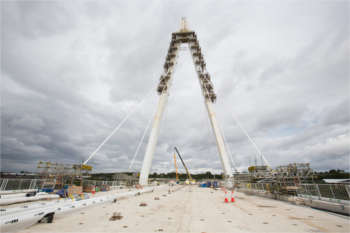The coming weeks will see a major engineering event in Sunderland as the 28 cable stays are fully installed on the New Wear Crossing.
The cable stays connect the bridge deck to the pylon and have a white protective sheath containing a collection of 44 to 77 individual wire strands varying in length from 52m to 165m.
One single strand on its own is strong enough to lift four fully-grown male African elephants, whilst just three strands could lift the Space Shuttle.

Cable stay installation on the New Wear Crossing is underway
Initial work to install the first 12 has already been carried out, with the remaining cables being attached in the coming weeks. The cable stays will be anchored into the pylon and the outer sides of the bridge deck.
Sunderland City Council Leader Cllr Paul Watson, said: ‘The installation of the cable stays is one of the final pieces of the jigsaw as we near completion of Sunderland’s new bridge. Bit by bit, we can really start to see just how impressive the new bridge is going to look.
‘Watching the bridge come to life during the past two years, and witnessing some of the engineering feats involved, has been tremendous. The teams working on the project are doing a terrific job. Some of the facts and figures around the cable installation process, including the strength and capacity of the materials used, are quite incredible.’
Structural engineering company VSL International is expected to take a further six weeks to install the cables and tension them to around 50% of their working load
Once the cables are in place, the project team will carry out the road finishing works on the deck and start installing the lighting system.
Only when most of the works are complete can the cable stays be tensioned to 100%, enabling the blue temporary steel towers in the river, which currently support the deck, to be removed.
Each strand in the cables is made up of several individual wires, which combine to form a diameter equal to that of a penny and which can support up to 28 tonnes, although they will only be tensioned to support seven tonnes on the New Wear Crossing. Once complete, 120 miles of strands will have been used.

Cable stays between the pylon and the bridge deck
Farrans Construction and Victor Buyck Steel Construction created the FVB joint venture to deliver the project on behalf of Sunderland City Council,
Stephen McCaffrey, FVB’s project director, said: ‘It’s easy to look at the outer sheath for the cables and not realise the strength and complexity of the technology that sits within them. Fixing these cables is a hugely specialised job and it will be our core focus for the work on the bridge itself for the coming weeks.’
The New Wear Crossing is Phase Two of the Sunderland Strategic Transport Corridor, which aims to improve links between the A19 and Sunderland City Centre and the Port of Sunderland. It is on track to be complete in the spring of next year.
It will cross the River Wear between Castletown and Pallion.
Cable information
- There are 28 cable stays on the New Wear Crossing in total, installed in pairs north and south of the central pylon
- The tube is erected first and then a collection of wire strands are threaded through it to form one cable
- They are secured inside two anchors, one within the pylon and the other on the outer sides of the bridge deck
- Each strand is the diameter of a penny and will be tensioned to lift 7 tonnes – the equivalent of a fully grown, male African elephant – however, they have the capacity to lift almost four times that amount – 27.9 tonnes.
- That means a tube containing the maximum 77 strands will be tensioned to have the capacity to lift 539 tonnes – the equivalent of 77 elephants or 45 double decker buses. In reality, however, they could lift far more if required.
- In total, there will be 120 miles of strands used on the New Wear Crossing. If laid end to end these would stretch, as the crow flies, to Liverpool in the west, Lincoln to the south east, or as far north as Falkirk.
- The cables are fixed at the deck and adjusted in the pylon to lift the deck off its temporary supports.
- The aim of the cables is to adjust the deck to the optimum shape to accommodate the loads of traffic and to take the weight of the bridge itself.
- The cables transfer the bridge loads up to the pylon before they pass down into the foundations in the centre of the river.
Register now for full access
Register just once to get unrestricted, real-time coverage of the issues and challenges facing UK transport and highways engineers.
Full website content includes the latest news, exclusive commentary from leading industry figures and detailed topical analysis of the highways, transportation, environment and place-shaping sectors.
Use the link below to register your details for full, free access.
Already a registered? Login